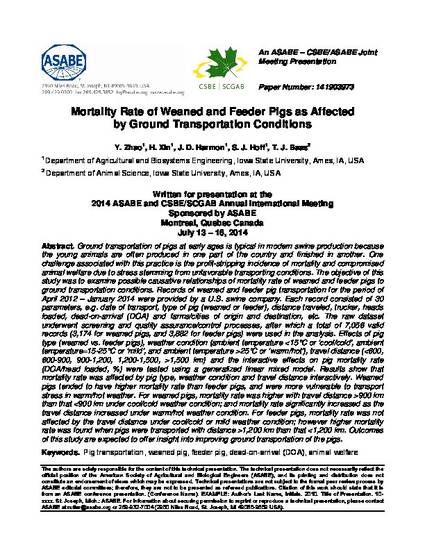
Ground transportation of pigs at early ages is typical in modern swine production because the young animals are often produced in one part of the country and finished in another. One challenge associated with this practice is the profit-stripping incidence of mortality and compromised animal welfare due to stress stemming from unfavorable transporting conditions. The objective of this study was to examine possible causative relationships of mortality rate of weaned and feeder pigs to ground transportation conditions. Records of weaned and feeder pig transportation for the period of April 2012 – January 2014 were provided by a U.S. swine company. Each record consisted of 30 parameters, e.g. date of transport, type of pig (weaned or feeder), distance traveled, trucker, heads loaded, dead-on-arrival (DOA) and farms/cities of origin and destination, etc. The raw dataset underwent screening and quality assurance/control processes, after which a total of 7,056 valid records (3,174 for weaned pigs, and 3,882 for feeder pigs) were used in the analysis. Effects of pig type (weaned vs. feeder pigs), weather condition (ambient temperature <15°C or ‘cool/cold’, ambient temperature=15-25°C or ‘mild’, and ambient temperature >25°C or ‘warm/hot’), travel distance (<600, 600-900, 900-1,200, 1,200-1,500, >1,500 km) and the interactive effects on pig mortality rate (DOA/head loaded, %) were tested using a generalized linear mixed model. Results show that mortality rate was affected by pig type, weather condition and travel distance interactively. Weaned pigs tended to have higher mortality rate than feeder pigs, and were more vulnerable to transport stress in warm/hot weather. For weaned pigs, mortality rate was higher with travel distance >900 km than that <900 km under cool/cold weather condition; and mortality rate significantly increased as the travel distance increased under warm/hot weather condition. For feeder pigs, mortality rate was not affected by the travel distance under cool/cold or mild weather condition; however higher mortality rate was found when pigs were transported with distance >1,200 km than that <1,200 km. Outcomes of this study are expected to offer insight into improving ground transportation of the pigs.
Available at: http://works.bepress.com/steven_hoff/124/
